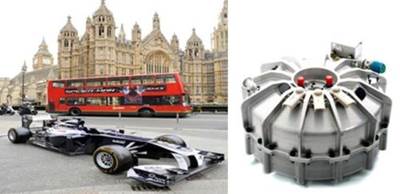Regenerative braking system to reduce carbon footprint of trains with composite flywheels
Ricardo delivers it lastest TorqStor high-speed energy storage system for DDflyTrain project aimed to cut fuel consumption and pollution while increasing acceleration and existing rail line capacity for diesel trains.
A new flywheel-based regenerative braking system has shown it can reduce the carbon footprint of trains, with the potential to also increase capacity on crowded lines. It comprises the Digital Displacement hydraulic pump-motor transmission system from Artemis Intelligent Power (Loanhead, UK) to store and reuse energy using Ricardo’s (Shoreham-by-Sea, West Sussex, UK) TorqStor high speed flywheels spinning at 45,000rev/min. Including rail technology company Bombardier Transportation (Berlin, Germany), the DDflyTrain consortium aims to demonstrate that this technology could work in a diesel environment on trains with multiple units.
In an article by theengineer.co.uk author Julia Pierce, “Every train journey involves a lot of stopping and starting, and so also a lot of braking and acceleration,” said David Rollafson, VP global innovation at Ricardo. “If we can harvest some of the energy from braking and use this when the vehicle is gathering speed again, we can save a lot of diesel and so a lot of money for train operators.”
Pollution would also be reduced. “When pulling out of a station, diesel engines . . . pump out a lot of pollution,’ said Rollafson. “Adding stored energy to help acceleration would reduce this.” Diesel locomotives are also slower to accelerate compared to electric trains. Using energy stored in the TorqStor flywheel would improve this, and could increase capacity on existing rail lines. The DDflyTrain system is reportedly easy to retrofit, and is also modular, meaning that operators could scale up their energy storage as finances allowed. The consortium is now discussing application of their technology with a number of UK train operators.
Ricardo’s TorqStor technology combines a modular, high efficiency, carbon fiber composite flywheel with a magnetic coupling and gearing system to enable a scalable range of energy storage capacities for different equipment applications. Its innovative magnetic coupling also enables the unit to operate in a permanently sealed vacuum and permits ease of in-field maintenance. Thus, it provides an industrial design for deployment in real-world applications where durability and easy serviceability are critical.
“This latest generation of Ricardo’s TorqStor high speed flywheel energy storage technology is a breakthrough in terms of cost reduction and light-weighting as well as in energy storage efficiency,” said Rollafson. “It can be integrated into mechanical, electrical or – as in the case of this first rail unit – an advanced hydraulic transmission system, providing a modular energy storage solution that scales seamlessly from 250KJ to 4MJ to support a wide variety of applications without the cost of multiple variants.”
In April of this year TorqStor was recognized with a prestigious ‘Tech Award’, as one of the top five technologies displayed at the SAE World Congress. This was followed by the DDflyTrain project's award for ‘Most Interesting initiative in safety and sustainability’ at the annual Rail Exec gala dinner.
“The delivery of the first TorqStor to be deployed for a railway application is a significant milestone,” continues Rollafson. “This game-changing technology offers transformative potential to reduce costs and save fuel across a range of applications from commercial on-highway trucks to mining and construction equipment. We are actively seeking further opportunities to realize the benefits of TorqStor in new sectors. In each case we believe that the technology can offer manufacturers a pathway to accelerated market introduction of high speed flywheel energy storage based on the development of our evaluation prototype units such as the one delivered today to Artemis Intelligent Power.”
Related Content
Wave of Hexagon Agility orders progress North American CNG truck market
Natural gas (CNG/RNG) fuel systems provider adds $4.2 million for fuel systems installations to delivery lineup.
Read MoreHexagon Digital Wave provides requalification services for oilfield service company’s gas transportation fleet
Noninvasive modal acoustic emission (MAE) technology will support composite cylinder inspection for the U.S. company’s virtual pipeline trailers through 2027.
Read MoreComposite Braiding awarded for TPC twin track cantilever support
Railway infrastructure cuts weight by 84%, carbon emissions by 80% and installation time by 50% while automated process offers ≥90% lower labor costs, waste and energy use versus traditional composites manufacturing.
Read MoreTransRail Connection announces ninth edition dedicated to rail, urban mobility
The two-day October 2025 event in France provides a crossroads for companies, startups, labs and research centers to exchange ideas and innovations modernizing rail and urban mobility ecosystems.
Read MoreRead Next
Composite flywheels: Finally picking up speed?
A wave of new composite flywheel developments for bus, rail, auto, heavy truck, construction equipment, and power grid support promises fuel savings, improved efficiency and reduced emissions — i.e. sustainability in the global quest for more energy.
Read MoreNext-gen fan blades: Hybrid twin RTM, printed sensors, laser shock disassembly
MORPHO project demonstrates blade with 20% faster RTM cure cycle, uses AI-based monitoring for improved maintenance/life cycle management and proves laser shock disassembly for recycling.
Read MoreCutting 100 pounds, certification time for the X-59 nose cone
Swift Engineering used HyperX software to remove 100 pounds from 38-foot graphite/epoxy cored nose cone for X-59 supersonic aircraft.
Read More











